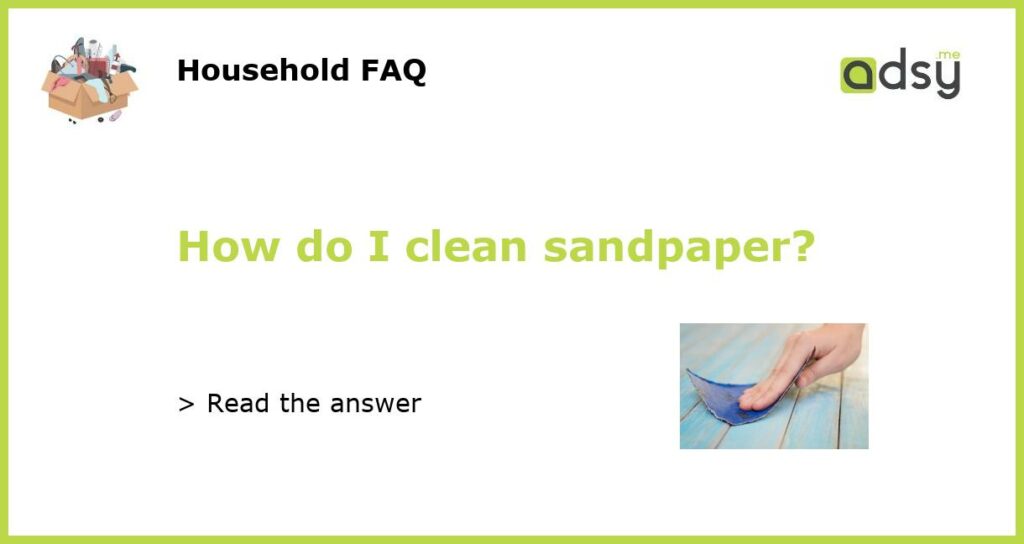How to Clean Sandpaper: 5 Effective Methods You Need to Know
As any craftsman or DIY enthusiast knows, sandpaper is an essential tool for smoothing surfaces and preparing them for finishing. But over time, sandpaper can become clogged with dust, debris, and resin, reducing its effectiveness. So, how do you clean sandpaper and extend its lifespan? In this article, we will discuss five effective methods for cleaning sandpaper and getting the most out of your abrasive sheets.
Use a Sandpaper Cleaner
Many manufacturers produce sandpaper cleaners specifically designed to remove debris from the abrasive surface. These cleaners are usually in the form of a rubber block or stick that you rub against the clogged sandpaper. The rubber material grabs the dust and debris, pulling it away from the abrasive surface and restoring its effectiveness.
To clean the sandpaper using a sandpaper cleaner, simply hold the block/stick at a 45-degree angle and apply light pressure while moving it back and forth along the length of the sandpaper. Make sure to clean both sides of the paper thoroughly. Once cleaned, the sandpaper should be ready to use again.
Use a Wire Brush
If you don’t have a sandpaper cleaner, a wire brush can be a handy alternative tool for cleaning sandpaper. A small wire brush with stiff bristles can effectively remove dust, debris, and resin buildup from the abrasive surface.
To clean sandpaper with a wire brush, simply hold the sandpaper firmly and briskly brush the wire brush across the surface in one direction. As you brush, the bristles will dislodge the clogged material and restore the sandpaper’s cutting ability. Remember to brush both sides of the sandpaper to ensure a thorough clean.
Use Compressed Air
Another effective method for cleaning sandpaper is by using compressed air. This method is particularly useful for removing fine dust particles that may not be easily scrubbed off with a rubber cleaner or wire brush.
To clean the sandpaper using compressed air, hold the sandpaper sheet firmly and direct the nozzle of a compressed air canister or air compressor towards the clogged surface. Gently blow compressed air across the sandpaper, making sure to cover the entire surface. The force of the air will dislodge the trapped particles, leaving the sandpaper clean and ready for use.
Use a Cleaning Block
A cleaning block, also known as an abrasive cleaning pad, can be an effective tool for removing debris from sandpaper. These cleaning blocks are made of a dense rubbery material with fine abrasive particles embedded in it. They are designed to be used wet, which helps prevent clogging.
To clean sandpaper with a cleaning block, wet the block and press it firmly against the sandpaper’s surface. Move the block in circular motions to dislodge the debris. The combination of the rubbery material and fine abrasives helps remove clogged material without significantly wearing down the sandpaper surface.
Use Denatured Alcohol
For more stubborn resin and adhesive buildup on sandpaper, denatured alcohol can be an effective solution. Denatured alcohol is a solvent that can dissolve sticky substances without damaging the sandpaper grit.
To clean sandpaper with denatured alcohol, dip a clean cloth or paper towel into the alcohol and scrub the clogged surface of the sandpaper. Apply light to medium pressure and move the cloth in a circular motion. The alcohol will dissolve the resin and adhesive buildup, restoring the sandpaper’s cutting ability.
In conclusion, sandpaper can be effectively cleaned and restored using a variety of methods. Whether you have a specialized sandpaper cleaner, wire brush, compressed air, cleaning block, or denatured alcohol, you can choose the method that works best for you and your specific cleaning needs. By regularly cleaning your sandpaper, you can extend its lifespan and ensure that it continues to provide optimal results.






